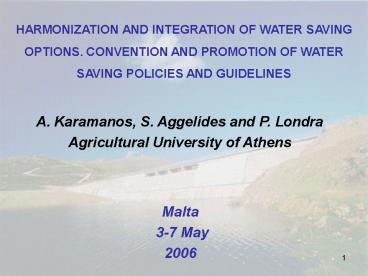IRRIGATION SYSTEMS PERFORMANCE IN GREECE - PowerPoint PPT Presentation
1 / 27
Title:
IRRIGATION SYSTEMS PERFORMANCE IN GREECE
Description:
Use of desalination water. Desalination systems based on renewable energy ... Desalination water can be used in some Cyclades islands in order to overcome the ... – PowerPoint PPT presentation
Number of Views:100
Avg rating:3.0/5.0
Title: IRRIGATION SYSTEMS PERFORMANCE IN GREECE
1
HARMONIZATION AND INTEGRATION OF WATER SAVING
OPTIONS. CONVENTION AND PROMOTION OF WATER SAVING
POLICIES AND GUIDELINES
A. Karamanos, S. Aggelides and P.
Londra Agricultural University of Athens
Malta 3-7 May 2006
2
- Population
- 11,000,000
- Area occupied
- 131,962 Km2
- Types of land use
- arable (30)
- forest (19)
- pastures (43.4)
- others (7.6)
3
- Total annual precipitation
- 116,689 hm3
- Annual water potential
- 70,276 hm3
- Annual water consumption
- 8,200 hm3
- agriculture (83)
- domestic (13)
- industrial (2)
- other uses (2)
4
Arable area 38,986 Km2Cultivated area
34,638 Km2Irrigated land 14,305 Km2
5
WATER SAVING ASPECTS
- Increase the drip irrigation systems
- Increase the water use efficiency in irrigation
networks. - Water saving practices in farm level.
- Water saving in irrigation districts or regions.
- Water saving techniques related to water
harvesting. - Recharging the degraded aquifers.
- Non-conventional water use.
- Use of desalination water.
- Affecting the water balance.
- Application of rational agricultural practices.
6
Increase the drip irrigation system
7
Increase the drip irrigation system
The trends of irrigation techniques used in
public networks.
8
- Increase the drip irrigation system
The trends of irrigation methods used in private
networks.
9
- Increase the drip irrigation system
Conveyance of irrigation water in public
networks.
10
- Increase the drip irrigation system
Conveyance of irrigation water in private
networks.
11
- Increase the water use efficiency in irrigation
networks.
12
- Increase the water use efficiency in irrigation
networks.
13
- Increase the water use efficiency in irrigation
networks
Maximum calculated crop water requirements
4,089 Km3 Actual water use
6,833 Km3 WUE
60
Data 1996
14
- Water saving practices in farm level.
- Storage water in farm reservoirs
- Destroy the weeds
- Using mulch
- Using minimum tillage techniques.
- Construction of terraces
15
- Water saving in irrigation districts or regions.
- Construction of dams.
- Construction off-stream water reservoirs.
16
- Water saving techniques related to water
harvesting
- Structures which harvest runoff from ground
surfaces (contour earth bands) - Structures which harvest the rain from the roofs
and ground surfaces and deposit water in
rain-water tanks. - Techniques which collect discharge by diversion
the ephemeral water sources.
17
- Recharging the degraded aquifers.
Recharge takes place during winter when there is
enough rainfall. Following this technique the
water quantity of the aquifers is increased and
the quality of degraded groundwater is improved.
18
- Non-conventional water use
The use of wastewaters from treatment plants may
provide sufficient water for irrigation, in order
to prevent water shortage as well as intrusion of
the pollution loads to the sea, rivers and lakes.
19
- Use of desalination water.
Desalination systems based on renewable energy
were used in some islands of Aegean Sea.
20
- Affecting the water balance
Water balance per water district (hm3).
21
- Affecting the water balance
- Application of appropriate agricultural practices
in order to increase infiltrated water especially
in the slopping cultivated areas, i.e. plowing
according to the contour lines, cultivation in
zones, using minimum tillage techniques etc. - Low rock dams in winter water courses.
- Measures to avoid forest fires.
22
- Application of rational agricultural practices
- Avoid erosion
- Avoid chemical pollution of soils and ground
waters
23
BENEFITS OF WATER SAVING OPTIONS. PROPOSITIONS ON
MEASURES.
- Water saving requires coordinated actions in
order to promote water resources management
through an integrated and effective planning
framework. - A reasonable quantity of water can be saved by
replacing the old surface irrigation systems with
drip irrigation ones. This policy can be improved
by subsidizing the purchase and establishment of
drip irrigation systems. - The increase of water use efficiency can be
achieved by applying the following measures
- Training of young farmers in water management
techniques. - Pricing of irrigation water in public networks is
based on the size of the parcel. Farmers should
pay on water volume consumption basis, instead.
24
BENEFITS OF WATER SAVING OPTIONS. PROPOSITIONS ON
MEASURES
- The construction of dams and off-stream water
reservoirs as well as projects for recharging
coastal aquifers need large investments.
Nevertheless, by converting a dry or degraded
land to irrigated one the family income is
increased by more than 70 as well as the
employment at a rate of 20 in the perimeter of
the project district. In addition a reduction in
labor cost was observed as a result of
automations (Naftemporiki Newspaper, 2004). - The effluents can be used to irrigate crops,
forestry, amenities and for industrial needs.
Thus the freshwater that is currently used for
irrigation can be saved. - Desalination water can be used in some
Cyclades islands in order to overcome the
competition between the vital economic sectors of
agriculture and tourism.
25
BENEFITS OF WATER SAVING OPTIONS. PROPOSITIONS ON
MEASURES
- Encouraging and subsidizing any measure or
technique that affects positively the water
balance - Administrative measures must be applied in
order to avoid the environmental degradation of
soils and ground waters from nitrates,
herbicides, fungicides and pesticides as well as
of forests from fires
26
The possible water saving opportunities in Greece
can be obtained mainly from
- The reuse of effluents from Waste Water Treatment
Plants by 3.2 of current total use of
freshwater. - The reduction of water losses in the irrigation
networks by 10 to 30 of the water used for
agriculture. - The different water saving options by an
inestimable proportion (10 ?).
27
Thank you !
Agricultural University of Athens

